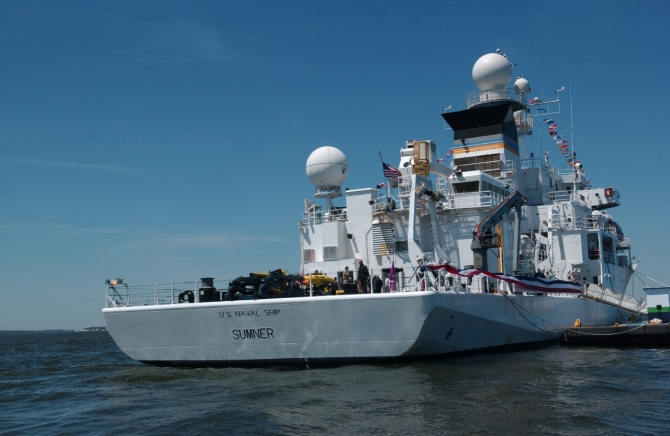Sumner III (T-AGS-61)
1995–
The first Sumner (DD-333) honored the late Capt. Allen Melancthon Sumner Jr., USMC (1 October 1882–19 July 1918). The second Sumner was commissioned as submarine tender Bushnell (AS-2) on 24 November 1915. On 25 July 1940 she was redesignated a surveying ship (AG-32) and on 23 August renamed Sumner for Thomas Hubbard Sumner (20 March 1807–9 March 1876), who invented the celestial navigation method known as a line of position. Destroyer Allen M. Sumner (DD-692) also honored the U.S. marine officer for whom the first Sumner had been named, but the full name was used to avoid confusion with the surveying ship.
III
(T-AGS-61: displacement 5,000; length 329'; beam 58'; draft 19'; speed 16 knots; complement 51; armament none; class Pathfinder)
The third Sumner (T-AGS-61) was laid down on 18 November 1992 at Moss Point, Miss., by Halter Marine, Inc.; launched on 28 February 1994; cosponsored by Mrs. Marian Croyle, widow of the late Carlton R. Croyle Jr., Program Manager, Pathfinder class, and Mrs. Pamela DeLeo, widow of the late Robert M. DeLeo, Project Engineer, Pathfinder class; and was placed in service with the Military Sealift Command (MSC) on 29 May 1995.
The MSC’s Special Mission program supports worldwide oceanographic programs with ships like Sumner that perform acoustical, biological, physical, and geophysical surveys. These ships gather data that provides much of the military’s information on the ocean environment. The collected data helps to improve technology in undersea warfare and detecting enemy ships. Sumner will have three multipurpose cranes and five winches, plus a variety of oceanographic equipment including multibeam echo-sounders, towed sonars, and expendable sensors that will enable her to continuously chart a broad strip of the ocean’s floor.
In the wake of the magnitude 7.3 earthquake that devastated Port-au-Prince, Haiti, killing an estimated 230,000 people, on 12 January 2010, the U.S. initiated Operation Unified Response to provide humanitarian aid to the victims. Sumner lay at Port Canaveral, Fla., when the disaster struck. She was capable of carrying 34-foot hydrographic survey launches (HSLs) that could survey in water less than 10 meters in depth, but had not embarked any of the launches. Oceanographic survey ship Henson (T-AGS-63) carried two HSLs but was conducting surveys in the Eastern Pacific Ocean. She received orders to come about and make speed for Haitian waters via the Panama Canal. Sumner’s crewmembers quickly loaded the equipment and embarked the people that Henson’s mariners would need to complete their humanitarian mission, and steamed to Naval Station Guantánamo Bay, Cuba. Sumner unloaded the gear and disembarked the people on 20 January, and Henson subsequently loaded and used them to help her survey safe navigational channels for some of the relief ships.

Sumner was stricken on 29 August 2014.
Detailed history pending.
Mark L. Evans
15 December 2015


